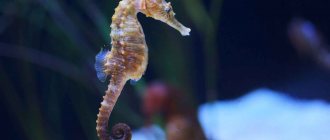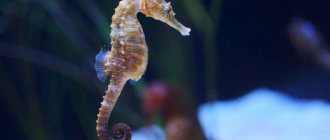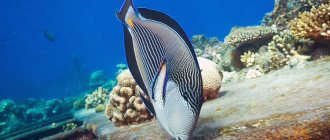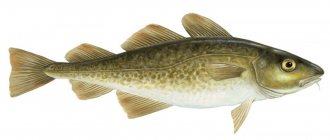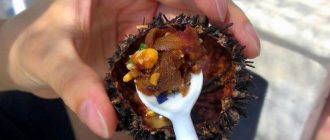The sea urchin (Echinoidea) is a unique animal in appearance that lives in the depths of the salty waters of the seas and oceans. Most of its species, despite their terrifying “prickly” appearance, are absolutely safe for humans. You can even pick up some of them without fear of getting hurt by sharp needles. Others have such small spines that they seem velvety to the touch, but there are also poisonous representatives of these marine inhabitants. It is a useful object from a culinary and medicinal point of view, and is also popular for cosmetic purposes. Sea urchin caviar is considered especially useful and valuable [1].
Description and habitat
Sea urchins have a round body, reaching up to 30 cm in size. On top it is covered with a calcareous shell or shell, which allows you to change the shape of the body [2]. According to their structure, sea urchins are divided into regular and irregular. Regular ones have an almost perfectly round body and pentaradial symmetry, while irregular ones have a flatter body with distinguishable anterior and posterior ends [3].
Content:
- Description and habitat
- Nutrition and lifestyle
- Composition and beneficial properties
- Application in medicine
- Use in cooking
- How to select and store
- Use in cosmetology
- Harm and dangerous properties of sea urchins
- conclusions
Needles of varying lengths are movably connected to the shell of a sea urchin, which makes it look like a land relative or a porcupine. Quills mainly serve for protection, locomotion and feeding [4]. Also on the surface of the shell of hedgehogs are pedicellaria and special organs necessary for balance - spheridia.
Some species of echinoderms are equipped with poisonous glands, and a meeting with such representatives can end in disaster. They live mainly in tropical and subtropical regions of the Pacific, Indian and Atlantic oceans.
The sea urchin's mouth is located in the upper part of the body. It has a special chewing apparatus that allows it to scrape algae from stones and also serves as a support for the animal’s movement. This structure is typical for regular sea urchins, but irregular sea urchins, which feed on detritus, do not have such an apparatus.
The intestine is a spiral tube that runs inside the body. For breathing, the hedgehog uses external gills, the ambulacral system and the accessory gut. The organs of touch and smell are poorly developed. In addition to spheridia and ambulacral legs, the hedgehog has small eyes on the upper side of the body.
Sea urchins are widespread in fairly salty seas and oceans. They live at a depth of up to 7 km. They can often be found on coral reefs and shallows, as well as in coastal areas. They settle in rocks and deep crevices, digging holes for themselves even in hard granite. Irregular hedgehogs prefer soft sandy soil, into which they also successfully burrow. You will not find sea urchins in the slightly salty waters of the Black, Caspian and Baltic seas.
Keeping in an aquarium
Before getting a sea urchin, it is worth getting acquainted with the living conditions of the handsome creature and its behavior. On one side of the issue is the beauty of the animal and the cleanliness of the aquarium, on the other is the mess created by this animal.
Conditions of detention
Sea urchins grow quickly and love light, so their pets need a spacious home with a volume of 200 liters. If hedgehogs are large species or have long spines, you should take a 400-liter container and provide good lighting. It is worth remembering that sea urchins are used to camouflage, so they catch everything they come across on their needles. These strong men are able to move an object that exceeds their weight by 40-50 times.
To maintain order inside the aquarium, decorative elements will have to be securely fastened. In addition, you will have to be prepared for the fact that pets will soon chew on decorative elements that will need replacement.
Caring for hedgehogs is not difficult. The hedgehog's spines will tell you about the condition of the water. If they droop, it’s time to check the water and give your pet calcium. In order not to harm your own health, it is not recommended to pet the hedgehog or take it out of the water.
Compatibility with fish
Sea urchins are not interested in fish, so it is not scary to place them with such neighbors. They also don’t offend each other, but only if they are well-fed, so they need to be fed properly. Fish also do not offend hedgehogs, because they know how to defend themselves. The only concern is Triggerfish, which like to flip hedgehogs over and bite the lower soft part of the body.
Feeding
Domestic herbivorous sea urchins are fed algae, lettuce and dandelion leaves, and pieces of carrots, fruits and vegetables. In addition, special industrial food is added in frozen or dry form. Omnivorous inhabitants are provided with adequate nutrition so that they do not eat their neighbors. Feed with lean meat, pieces of beef, fish, and shrimp.
How much are
Young sea urchins cost from $10 to $30. To purchase, go to a pet store or find a suitable hedgehog on the online store’s website.
Dear readers, we are interested to know who has these prickly pets and how much trouble they cause. Did the content of the article help answer your questions regarding sea urchins?
Nutrition and lifestyle
Basically, sea urchins are omnivores. They feed on algae, a variety of marine organisms, mollusks, starfish, and even eat their own kind. Those species that settle in sandy burrows can swallow sand and eat small organisms that get caught with it.
By hiding in the spines of sea urchins, some marine microorganisms create cozy protection from predators. The hedgehog is also an easy prey for parasitic mollusks, which drill into its shell and feed on the delicate tissues.
The sea otter, a predatory sea otter, is considered a terrible enemy of the sea urchin. He is so addicted to eating these animals that even their bones are painted purple with hedgehog pigments. The sea otter either smashes the hedgehog with stones, or first twirls it in its paws for a long time, wrapping it in seaweed to crush the needles, and then digs into it with its teeth. Also unsafe for hedgehogs are lobsters, starfish, fish, birds and fur seals.
Hedgehogs are dioecious animals that reproduce by laying eggs in shallow water or coastal rocks.
The average lifespan of sea urchins is approximately 15 years. There are legends telling about the immortality of hedgehogs, according to which adult individuals did not experience any changes or signs of aging.
Enemies of the sea urchin
Despite their seemingly good protection, sea urchins are food for birds, mammals and large fish. The otter loves to feast on the meat of sea urchins. Having caught the prickly ball, the otter throws it onto the stones, thereby breaking its strong shell. Seabirds do exactly the same thing when hunting sea urchins. Large birds grab the sea urchin with their beaks and rise to a great height, where they throw the spiny animal onto the rocks. Then, the bird pecks out soft pieces from the broken shell.
Composition and beneficial properties
Sea urchin is valued for its rich vitamin and mineral composition. It feeds on healthy seaweed, thereby accumulating all the valuable substances and microelements that are present in its caviar.
Sea urchin caviar contains useful minerals such as:
- potassium;
- calcium;
- magnesium;
- zinc;
- iron;
- phosphorus;
- iodine.
Vitamins A, , , and B vitamins (thiamine, riboflavin, and others) are present in large quantities. It is a rich source of omega-6 and omega-3 fatty acids, as well as nonessential and essential amino acids (phenylalanine, glutamic acid, glycine) [5].
The calorie content of the product is about 86 kcal per 100 grams. The protein content is approximately 13.8 grams, fat accounts for 4.3 grams, and carbohydrates account for 2.5 grams [6].
Regular consumption of sea urchin caviar will bring invaluable benefits to the human body. Lecithin, which is part of it, has a positive effect on the functioning of the liver and brain, helps get rid of harmful and dangerous toxins, waste, and reduces cholesterol levels [7]. The omega fatty acids it contains will charge you with energy and vigor, help cope with depression, and restore cheerfulness and optimism. A high iodine content promotes stable functioning of the endocrine system and is a prevention of thyroid diseases. Sea urchin caviar has the ability to remove toxins, radionuclides and harmful substances from the body, and helps restore the body after chemotherapy and radiation sickness. This product was quite often included in the Japanese diet after the bombings of Hiroshima and Nagasaki.
The most delicious is gray
The diameter of the shell of a gray sea urchin can reach up to 8 cm, and the weight can reach 160 g. Sexual maturity occurs in the third year of life, and the urchin lives up to 7-10 years. As a rule, it is not found in significant quantities deeper than 40 m. It feeds mainly on algae on rocky and pebble soils, preferring seaweed. However, it does not disdain animal food in the form of dead marine life.
In our temperate waters, characterized by significant seasonal fluctuations in water temperature at shallow depths, seasonality in the development of gonads in hedgehogs is also well expressed, which is taken into account when fishing. For example, on the Kuril Islands the urchin fishing season is longer than off the coast of Primorye. In winter there is little “caviar”; collection is carried out, as a rule, in the summer months. However, immediately before and during spawning, the glands “flow” and the product is almost impossible to collect. After spawning, the iron is still small.
The gray urchin fishery in the Russian Far East has been carried out for a long time. In Soviet times, canned food called “Sea Urchin Caviar” was supplied in small quantities to the domestic market - to Vladivostok and other cities. Small jars were expensive, and their very salty contents could not be called a delicacy. Perhaps these were defective batches. A decent product arrived on the foreign market - Japan. But few Russian citizens were lucky enough to visit this country at that time, much less decide to spend foreign currency on such an exotic product.
Nevertheless, it was known from rumors and translated literature that regular consumption of fresh “caviar”, even from two hedgehogs, improves health and ensures longevity of a person. But this delicacy was not available to every Japanese at that time. Here, not far from Vladivostok in the 70s and 80s. last century with only a mask and snorkel - without scuba gear! – you could easily get a hundred or two sea urchins. However, there were almost no domestic lovers of a “dense” snack on this healthy delicacy at that time. Now, when diving near tourist rookeries, even with scuba diving, you cannot find even small concentrations of gray urchins.
Application in medicine
The medicinal properties of sea urchin caviar have been noticed and appreciated for quite some time. This product contains so many useful substances, vitamins and minerals that it is often used for the treatment and prevention of various diseases [8]. Research by scientists in the field of oncological diseases has shown that some substances contained in sea urchin caviar are capable of infecting cancer cells, while healthy cells undergo a kind of purification [9], [10].
Regular consumption of caviar from these animals contributes to:
- normalization of blood pressure;
- increasing potency;
- removal of harmful substances, radionuclides and toxins from the body;
- increasing immunity and improving the body’s protective function;
- improving thyroid function and sexual function;
- normalization of the cardiovascular system;
- restoration of the body after radiation and chemotherapy;
- prevention of gastritis, ulcers, diseases of the gastrointestinal tract [11], [12].
Russian scientists from the space research center have developed special tablets based on the medicinal properties of sea urchin caviar, used during extreme physical activity. These tablets help astronauts avoid physical and nervous exhaustion during space flights.
Nutritionists from the Primorsky Territory have created a strong alcohol tincture based on sea urchin caviar. This product is widely used in medicine as a homeopathic tonic. The medicine helps to increase sexual desire, improves immunity and increases the body's protective properties. The tincture can help avoid alcohol intoxication. To do this, you need to take it before and after drinking alcohol.
Sea urchin caviar tincture recipe
The recipe for making this tincture is extremely simple. You should sort the caviar, rinse it well with warm sea water and pour it with a heated alcohol solution with a strength of up to 70% in a ratio of 1:25. The resulting product is left to infuse in a dark place for 4 days at room temperature. Then the solution is filtered and settled. In such a tincture, all the beneficial properties of caviar are preserved, and the healing drink acquires them in full.
They have no bones
Their body is covered with durable calcium plates. They are symmetrical and cover the body like an orange peel. These plates are symmetrical to each other, they are quite strong and protect internal organs from mechanical damage.
On average, hedgehogs reach a size of 10 cm. At the same time, the smallest species grow no more than 3 cm in diameter, and giants can reach 36 cm in diameter.
Photo: SmithsonianSMS/Flickr
Use in cooking
Sea urchin caviar is used to make sushi, salads and other cold dishes. It is often eaten fresh. If the caviar is bitter, you can add a few drops of lemon juice or soy sauce to it. In European cuisine, caviar undergoes heat treatment: it is fried and baked. From it you can prepare:
- Italian pasta or spaghetti;
- pates;
- various sauces;
- spices.
In Italy, sea urchins are also served with dessert dishes. Granite ice cream, which is made from fruit juice mixed with alcohol, is in great demand. Champagne is often used for this, which goes well with the caviar of these sea creatures.
Body structure
Most people associate a sea urchin with a creature that has a huge number of sharp spines, which is not entirely true. Some species of these creatures do not have spines at all and pose absolutely no danger to humans. There are species whose body is covered with a mass of small needles, which are not only incapable of injuring a person, but also make the sea creature very pleasant to the touch.
Some species of sea urchins do not have spines at all and pose no danger to humans.
Sea urchins are the oldest animals that appeared on earth more than 500 million years ago. Their closest relatives include no less ancient creatures - starfish. Sea urchins can be roughly divided into 2 large groups - regular and irregular. These groups include 4 more superorders, consisting of 9 orders. This diversity of classification suggests that the World Ocean is home to a great variety of different species of sea urchins, differing in a number of characteristics:
- body shape;
- the structure of the body;
- color;
- way of life.
Unlike the starfish, the hedgehog has no prominent rays on its body, and the animal itself has the shape of a flat disk or ball. The group of irregular hedgehogs includes creatures that are egg- or heart-shaped. Since the animal’s body is enclosed in a durable shell consisting of several plates, its shape remains unchanged throughout its life.
The closest relatives of sea urchins include starfish.
The structure of the shell is always the same . It consists of plates located along the meridians of the body. The mouth opening is located on the abdomen and always faces the bottom. On the opposite side is the anus. Near the mouth opening there are external gills and spheridia - organs responsible for balance.
In the depths of the mouth there is a chewing apparatus, consisting of several plates connected by muscles. The basis of the oral apparatus is 5 paired pyramids in which the teeth are located. Using its teeth, the animal scrapes algae from hard surfaces and captures a variety of food.
From the mouth to the anus there are ambulacral plates, each of which has several paired holes. The legs pass through these holes.
How to select and store
Best materials of the month
- Coronaviruses: SARS-CoV-2 (COVID-19)
- Antibiotics for the prevention and treatment of COVID-19: how effective are they?
- The most common "office" diseases
- Does vodka kill coronavirus?
- How to stay alive on our roads?
When choosing a delicacy, you need to pay attention to the color, smell and appearance of the product. The needles of a fresh hedgehog should stick out in different directions, and not adjacent to the body. The color of the caviar should be orange and not have an unpleasant odor.
It is best to store caviar in canned form. It is better not to store fresh product, but to eat it immediately. In the refrigerator or when frozen, the product loses its beneficial properties, acquires a bitter taste, and loses elasticity and quality.
Habitats
Sea urchins live only in warm waters with high salinity levels and are never found in fresh water. The bottom of all oceans is inhabited by various species of these animals. The most numerous populations live:
- in the Indian Ocean;
- in the Caribbean;
- on the east coast of Australia, washed by the Pacific Ocean;
- in the waters of the Hawaiian Islands.
Colonies of echinoderms can be found both at shallow depths in the area of underwater rocks and on deep-sea reefs. In shallow sea bays, as a rule, there are “spines” with a spherical body shape.
Flat-bodied species live at deeper depths. These creatures have never been seen in the basins of the Black and Caspian Seas, since the salinity level of the water in these reservoirs is extremely low.
Use in cosmetology
It is with the consumption of sea urchin caviar that the long life expectancy of the Japanese is associated. Japan has a national holiday that occurs once a year. On this day, you must buy a sea urchin and, having opened its shell, drink the liquid it contains and eat a piece of caviar. This ritual allows you to completely rejuvenate and refresh the body.
Sea urchin caviar is considered the elixir of youth and beauty. Sesame, saffron, noni, sea cucumber, beebread and yarsagumba also have properties similar to it in action.
The immune system of these marine representatives contributes to their longevity and immortality [13]. They can live up to 35 years (sometimes 200 years) without aging or losing the ability to reproduce [14]. Recently, American scientists found that their DNA is 70% identical to human DNA, so consuming this product gives the opportunity to rejuvenate the body and increase physical and mental abilities.
Kinds
The class of these echinoderms is very numerous. Therefore, animals belonging to it are conventionally divided into two subclasses. The first group is regular hedgehogs, that is, those whose body shape is spherical. The body of irregular echinoderms is more like a stretched disc. There are more than 900 species of animals, some of which are very common. These include: Black sea urchins, which have long spines. This animal poses a great danger to humans, as it has long spines. An interesting fact is that the beauty of a black hedgehog can quickly turn into its weapon: at any sign of danger, it directs its needles towards the irritant. That is, a shadow from any object falling on him can be regarded as an attack.
A round sea urchin that can also be dangerous to humans. It is one of the most common types.
Japanese sea urchin. The name tells you where it lives. This representative of echinoderms can attack a person if it senses danger emanating from it.
Slate sea urchin, which is distinguished by its amazing red color. Its needles have an unusual triangle shape with a blunt apex. According to one version, it got its name due to the fact that in ancient times they used its needles to write on slate boards.
A species such as a diadem is very dangerous for humans. At the slightest sign of danger, the animal pierces the skin of the victim with fragile needles, and they break. The process of removing them is very painful. This species is often found near the Turkish shores beloved by tourists.
Harm and dangerous properties of sea urchins
The thin and sharp needles of hedgehogs pose a danger to humans. Stepping on them can cause serious injury, as the needles usually break, leaving small elements in the foot. Some of the hedgehogs are highly poisonous. Once in the human body, the poison negatively affects the nervous system, causes paralysis, slows down the heart and makes breathing difficult.
The victim must immediately provide first aid by removing the elements of the needle and pedicellaria, and treating the stung area with an antiseptic solution. It is also recommended to keep the affected area in the hottest water that a person can withstand, since it is believed that the poison disintegrates when exposed to heat. It is advisable to take the victim to the hospital as soon as possible, where he will be under constant supervision.
Even without poison, getting a needle under the skin is fraught with unpleasant consequences, since bacteria located at the ends of the needles cause suppuration of the wound.
Needles
Lime sticks have a cylindrical shape. They are movably attached to the body, which allows them to easily rotate in different directions. They not only protect animals, but also help them move. Moreover, some of them have a grasping function.
In this case, it is customary to call these organs pedicellariae. Some of the needles contain poisonous glands that secrete a rather strong substance. Because these organs are shorter than others, regular needles move apart to release them. About 80 species of these animals are dangerous to humans due to their poison. The length of the needles can reach 30 cm in length.
Hedgehogs are dangerous or not: myths and truth
The first myth about sea urchins is that they are all poisonous. In fact, only a few species have glands with poison, most often we are talking about representatives of the genera Asthenosoma and Diadema, living in warm tropical waters. It is believed that the poison is contained only in the spines, although in some species it is found in the pedicillaries. When in danger, pedicillaria are thrown into the water. Toxins spread around the hedgehog, creating a protective “cloud” that repels the predator. According to some data, either needles or pedicillaria are poisonous.
You can die from the injection. This is another myth. Yes, injections are painful, toxins can cause dizziness, vasospasm, and severe intoxication. Over all this time, only a few cases of death of divers from poisonous needles have been recorded. But, most likely, this is the result of increased sensitivity to toxins, that is, an individual reaction. Or the result of loss of consciousness, a person may simply drown if he is not given help. If we take into account the number of poisonous individuals living in the ocean and the frequency of accidental contacts, statistics confirm that the poison itself is not dangerous to humans.
The most dangerous for humans are:
- Toxopneusthes hedgehog flower, native to the southeast Pacific coast. The effect of the poison is nerve-paralytic; it is the spasm that can lead to death.
- Asthenosoma: poison provokes disorders in the nervous system.
- Black diadems: although there is no particular toxicity in the poison, the danger lies in their prevalence in the shallow waters of the beaches of popular resorts in Egypt and Thailand. You rarely see them during the day, and a careless swimmer walking along the “safe” coastal zone in the evening may well become a victim of poisonous thorns.
- Striped: when in danger, it shoots out many pedicillaria, which end in chambers with toxin.
- Centrostephanus l. Longispinus: Found in the eastern Atlantic and Mediterranean. The animal is difficult to notice due to its ability to change color depending on the lighting.
These are the most famous poisonous hedgehogs.
It’s worth dispelling another myth: if it’s not poisonous, it’s not dangerous. This is not entirely true. In addition to a very painful injection, the danger lies in the non-sterility of the needles. Not only are they difficult to pull out, but the injection site is much more disturbing than with a splinter. There is a high risk of infection, which is common in countries with hot climates. Therefore, you cannot do without special treatment and the help of doctors even if you are “bitten” by a non-venomous individual.





